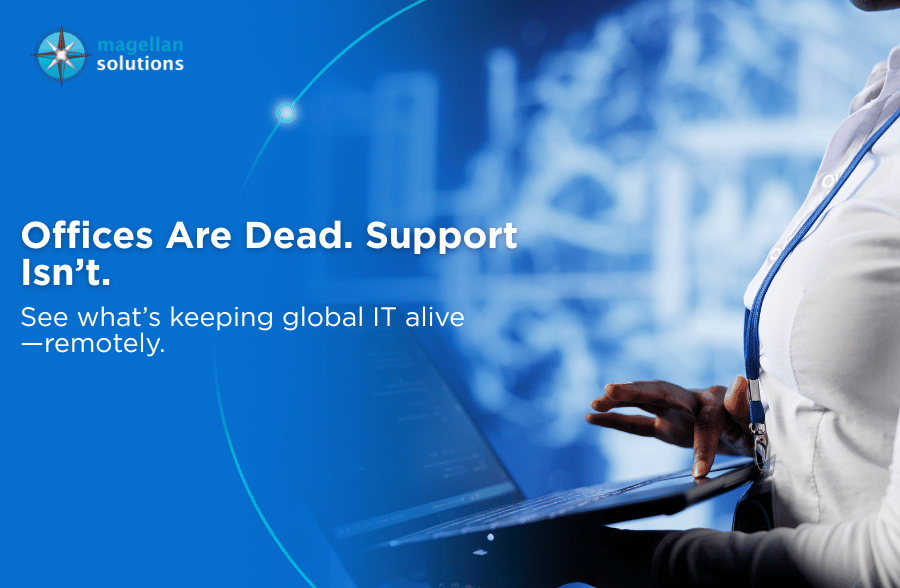Schedule a FREE call with our outsourcing expert now and get a precise quotation that meets your requirements. Don't wait - get started today!
Let’s face it—work has changed. For IT support, especially, the old model of being chained to an office desk is long gone. Today, remote helpdesk support isn’t just a nice alternative—it’s how agile businesses stay ahead. Flexibility has shifted from being a perk to a fundamental part of resilient, forward-thinking operations.
Remote IT helpdesk jobs now play a central role in keeping digital ecosystems alive and well. Whether it’s a simple login issue or a full-blown outage, these remote teams are the ones behind the scenes making sure everything keeps moving. They troubleshoot, guide, escalate, and resolve—all without setting foot in a client’s office.
At Magellan Solutions, we’ve worked with businesses that saw firsthand how remote support transformed their operations. It’s not just about cost—it’s about performance, coverage, and confidence that no matter where your team is, help is always one call (or click) away.
What remote IT Helpdesk Jobs Really Look Like
In practice, remote helpdesk support is a mix of rapid problem-solving, layered escalation, and clear communication. These aren’t faceless tech agents—they’re virtual lifelines when things go sideways.
Most support systems are built around three key tiers:
- Tier 1: The rapid responders—handling day-to-day issues like password resets or basic app errors.
- Tier 2: The troubleshooters—digging into system bugs, device misconfigurations, or tricky software conflicts.
- Tier 3: The specialists—handling security issues, infrastructure-level problems, and working closely with engineers when the stakes are high.
This structure allows issues to be filtered efficiently so the right expertise is applied without delay. That’s what keeps downtime low and satisfaction high.
Why Remote Helpdesk Support Isn’t Slowing Down Anytime Soon
This rise in remote IT helpdesk jobs isn’t just a product of the pandemic. It’s the result of long-term business trends:
- Global business hours: Clients expect help any time, anywhere.
- Cloud-first workflows: Platforms like Microsoft 365 and Salesforce don’t stop, and neither can they.
- Security risks: Remote access means more endpoints—and more opportunities for trouble.
- Growth without bloat: Companies want support that scales without adding internal complexity.
At the end of the day, businesses care less about where support agents are located and more about whether they can fix the issue fast.
The Functions Driving Remote Helpdesk Success
Forget job titles for a moment. Think of remote helpdesk teams as operating units. Each plays a part in keeping your tech stack humming:
- Frontline Support: These are the first voices users hear when things go wrong. They handle the basics with speed and accuracy.
- Technical Analysts: They tackle deeper issues, analyze logs, and coordinate escalations.
- Workflow Managers: Behind the scenes, they manage queues, track SLAs, and make sure requests get routed efficiently.
- App Support Specialists: Focused on keeping essential cloud tools online and integrated.
- Security-Aware Techs: With an eye on compliance and threat response, they bring extra vigilance to support environments.
Together, these roles form a robust safety net that keeps operations smooth even as teams grow or go remote.
What Sets Excellent Remote Support Apart
Great helpdesk support isn’t about doing the job—it’s about how the job gets done. The top performers in remote support don’t just solve—they anticipate, communicate, and prevent.
Here’s what elevates a good support team to a great one:
- Omnichannel fluency: They’re comfortable working across phone, email, chat, and ticketing platforms without skipping a beat.
- Solid documentation habits: They leave behind clear records so issues don’t repeat themselves.
- Cross-platform know-how: They move seamlessly between Windows, macOS, Linux, and remote access tools.
- User-first communication: They know how to calm a panicked user and explain without condescension.
- Credentialed expertise: Certifications like CompTIA A+ and ITIL Foundation add trust and reliability to every interaction.
These are the traits that help businesses turn helpdesk support from a pain point into a competitive advantage.
Why Companies Are Turning to Magellan Solutions
Outsourcing isn’t about cutting corners. It’s about getting better support, faster, without having to build it all from scratch. That’s where BPO firms like Magellan Solutions come in.
Our remote helpdesk services aren’t just plug-and-play. We customize workflows, train for your tech stack, and deliver performance that matches your internal standards. Based in the Philippines—a global hotspot for IT support outsourcing—we combine deep technical know-how with a culture grounded in service and accountability.
When you work with Magellan, you get:
- Professionals trained on today’s platforms and systems
- Global coverage and follow-the-sun support
- Custom-fit processes that match your priorities and SLAs
- Ongoing QA and reporting that keeps you in the loop
For businesses aiming to grow smart, stay lean, and keep clients happy, we help make that happen, without missing a step.
Looking Ahead: A Smarter Support Framework
Remote work isn’t fading away—and neither is the need for fast, reliable tech support. If anything, the stakes are getting higher. More tools, more users, more moving parts. A slow response or unresolved issue today could be tomorrow’s lost client.
Modern companies aren’t just thinking about uptime. They’re thinking about continuity, scalability, and client trust. And that means building helpdesk systems that are proactive, flexible, and built to evolve.
That’s what we do at Magellan Solutions. We help B2B teams support better, faster resolutions, smarter escalation paths, and 24/7 access to the people who know how to fix things when they go wrong.
Want to see what that looks like in action? Visit and contact Magellan-Solutions.com, and let’s talk about what your helpdesk could be.
Because when your support runs smoothly, everything else gets easier.















